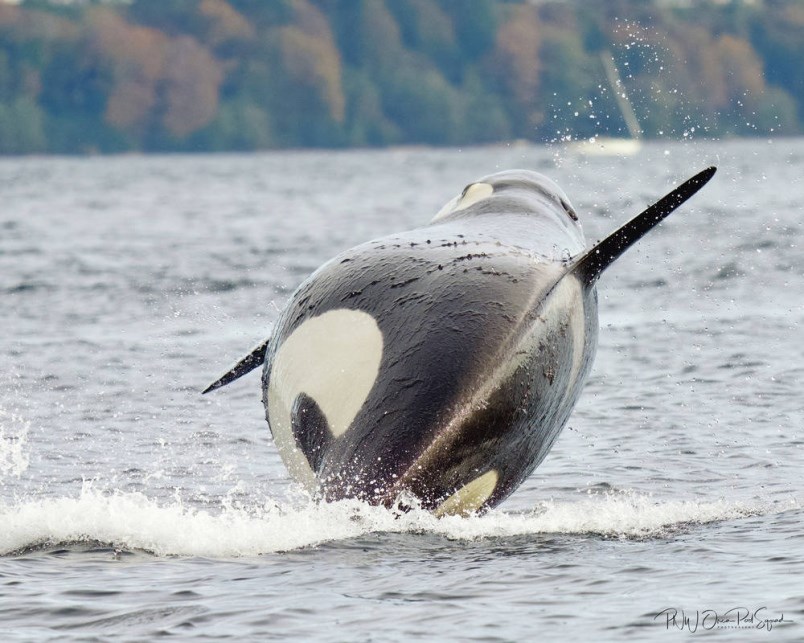A nurse on the front lines of COVID-19 in Seattle captured a hopeful image for the natural world this week, photographing what is very likely a pregnant female from the endangered J-Pod group of resident killer whales.
Brittany Philbin said she was “re-engergizing” from a hectic week of hospital work and decided to take a trip to Vashon Island, a short ferry ride from Seattle in Puget Sound, where orcas are often spotted from shore swimming through a narrow channel. Sure enough, members of J-Pod passed through and Philbin was ready with her camera. She captured what looks like a very pregnant J-46 during a sudden breach.
“It was a happy accident,” said Philbin. “It wasn’t until I was in the car on the ferry back to West Seattle that I realized the photo I took was actually in focus. I was convinced it was going to be blurry. It was then that I realized there was something different about this whale, that she looked huge, in a very good way.
“Turns out I was lucky to be standing at the right place, at the right time, with just the right angle to capture this photo. I’m cautiously optimistic about her pregnancy, but couldn’t be happier that we could be adding another J-pod whale to this incredible family.”
Although it hasn’t yet been confirmed officially, Philbin said two researchers have told her the whale is likely pregnant. Usually scientists take time to compare such images with footage of the whale’s body size from an earlier time period to determine if she is pregnant.
Kelley Balcomb-Bartock of the Pacific Whale Watch Association said several naturalists who have viewed the photo agree J-46 — also known as Star — is most likely carrying a calf.
“That’s quite a baby bump and she looks quite far along,” he said.
It would be the first known birth for 11-year-old J-46.
Balcomb-Bartock said indications are a birth could happen at any time, which would continue a small baby boom for J-Pod, which had two births in September.
J-35, known as Tahlequah, gave birth on Sept. 5 to a calf later confirmed to be a male. She made headlines around the world in 2018 when she lost a calf and pushed its lifeless body around the Salish Sea for 17 days.
On Sept. 25, J-41, or Eclipse, gave birth to another calf. This time, the birth was witnessed and photographed by naturalists Talia Goodyear and Leah Vanderwiel, along with passengers on an Orca Spirit Adventures whale-watching vessel near Victoria. The new calf’s sex has yet to be determined.
The population of southern resident killer whales now stands at 74 among J, K and L Pods. J-Pod has 24 whales.
Philbin, an avid whale watcher and a Canadian citizen whose family hails from Ontario, said a birth for J-46 is “great news” for the southern residents — and for Star. The female whale lost her mother, J28, and a brother, J54, in 2016.
Seeing members of J-Pod was also a personal reprieve from Philbin’s grinding daily routine as a hospital nurse.
“With everything happening this year around COVID-19, it was a great way to re-energize … seeing the whales so close and finding that Star looks pregnant,” said Philbin, who captured the image off Point Robinson Lighthouse.
Scientists hope for births of female calves to increase the population, but any births are a good sign, said Balcomb-Bartock. There has been concern for the resident whales as Chinook salmon stocks — their main food source — have been dwindling.
Balcomb-Bartock said J-Pod was absent from its traditional summer territory in the Salish Sea during May, June and August, suggesting they might have gone further afield in search of salmon.
But the pod has returned strong and fertile, with no indications any of the whales are starving, said Balcomb-Bartock.
He said the newest calves have been reported to be “robust and active,” adding there’s enough food for the recent mothers to nurse.
Read more from the Times Colonist



